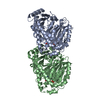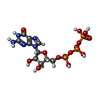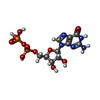[English] 日本語
 Yorodumi
Yorodumi- PDB-8sh7: TUBB4B and TUBA1A Heterodimer from Human Respiratory Doublet Micr... -
+ Open data
Open data
- Basic information
Basic information
| Entry | Database: PDB / ID: 8sh7 | ||||||||||||
|---|---|---|---|---|---|---|---|---|---|---|---|---|---|
| Title | TUBB4B and TUBA1A Heterodimer from Human Respiratory Doublet Microtubules | ||||||||||||
 Components Components |
| ||||||||||||
 Keywords Keywords | STRUCTURAL PROTEIN / Cilia / Axoneme / Microtubule | ||||||||||||
| Function / homology |  Function and homology information Function and homology informationPost-chaperonin tubulin folding pathway / axonemal microtubule / Cilium Assembly / cytoskeleton-dependent intracellular transport / organelle transport along microtubule / Microtubule-dependent trafficking of connexons from Golgi to the plasma membrane / Carboxyterminal post-translational modifications of tubulin / forebrain morphogenesis / Intraflagellar transport / Sealing of the nuclear envelope (NE) by ESCRT-III ...Post-chaperonin tubulin folding pathway / axonemal microtubule / Cilium Assembly / cytoskeleton-dependent intracellular transport / organelle transport along microtubule / Microtubule-dependent trafficking of connexons from Golgi to the plasma membrane / Carboxyterminal post-translational modifications of tubulin / forebrain morphogenesis / Intraflagellar transport / Sealing of the nuclear envelope (NE) by ESCRT-III / cerebellar cortex morphogenesis / glial cell differentiation / dentate gyrus development / Formation of tubulin folding intermediates by CCT/TriC / neuron projection arborization / flagellated sperm motility / Gap junction assembly / Prefoldin mediated transfer of substrate to CCT/TriC / Kinesins / COPI-independent Golgi-to-ER retrograde traffic / Assembly and cell surface presentation of NMDA receptors / response to L-glutamate / pyramidal neuron differentiation / centrosome cycle / COPI-dependent Golgi-to-ER retrograde traffic / smoothened signaling pathway / natural killer cell mediated cytotoxicity / regulation of synapse organization / startle response / motor behavior / response to tumor necrosis factor / Recycling pathway of L1 / microtubule polymerization / locomotory exploration behavior / MHC class I protein binding / sperm flagellum / response to mechanical stimulus / RHO GTPases activate IQGAPs / microtubule-based process / Hedgehog 'off' state / intercellular bridge / Activation of AMPK downstream of NMDARs / COPI-mediated anterograde transport / condensed chromosome / Mitotic Prometaphase / EML4 and NUDC in mitotic spindle formation / Loss of Nlp from mitotic centrosomes / Loss of proteins required for interphase microtubule organization from the centrosome / Recruitment of mitotic centrosome proteins and complexes / MHC class II antigen presentation / homeostasis of number of cells within a tissue / Recruitment of NuMA to mitotic centrosomes / Anchoring of the basal body to the plasma membrane / cellular response to calcium ion / HSP90 chaperone cycle for steroid hormone receptors (SHR) in the presence of ligand / Resolution of Sister Chromatid Cohesion / AURKA Activation by TPX2 / adult locomotory behavior / Translocation of SLC2A4 (GLUT4) to the plasma membrane / neuromuscular junction / intracellular protein transport / RHO GTPases Activate Formins / synapse organization / recycling endosome / PKR-mediated signaling / cerebral cortex development / visual learning / structural constituent of cytoskeleton / microtubule cytoskeleton organization / memory / cytoplasmic ribonucleoprotein granule / neuron migration / HCMV Early Events / Aggrephagy / The role of GTSE1 in G2/M progression after G2 checkpoint / mitotic spindle / Separation of Sister Chromatids / azurophil granule lumen / unfolded protein binding / Regulation of PLK1 Activity at G2/M Transition / mitotic cell cycle / extracellular vesicle / double-stranded RNA binding / microtubule cytoskeleton / neuron apoptotic process / Hydrolases; Acting on acid anhydrides; Acting on GTP to facilitate cellular and subcellular movement / gene expression / microtubule / cytoskeleton / hydrolase activity / cilium / protein heterodimerization activity / cell division / GTPase activity / Neutrophil degranulation / GTP binding / protein-containing complex binding / structural molecule activity / extracellular exosome / extracellular region Similarity search - Function | ||||||||||||
| Biological species |  Homo sapiens (human) Homo sapiens (human) | ||||||||||||
| Method | ELECTRON MICROSCOPY / single particle reconstruction / cryo EM / Resolution: 2.8 Å | ||||||||||||
 Authors Authors | Anderson, J.R. / Gui, M. / Brown, A. | ||||||||||||
| Funding support |  United States, 3items United States, 3items
| ||||||||||||
 Citation Citation |  Journal: Science / Year: 2024 Journal: Science / Year: 2024Title: Ciliopathy patient variants reveal organelle-specific functions for TUBB4B in axonemal microtubules. Authors: Daniel O Dodd / Sabrina Mechaussier / Patricia L Yeyati / Fraser McPhie / Jacob R Anderson / Chen Jing Khoo / Amelia Shoemark / Deepesh K Gupta / Thomas Attard / Maimoona A Zariwala / Marie ...Authors: Daniel O Dodd / Sabrina Mechaussier / Patricia L Yeyati / Fraser McPhie / Jacob R Anderson / Chen Jing Khoo / Amelia Shoemark / Deepesh K Gupta / Thomas Attard / Maimoona A Zariwala / Marie Legendre / Diana Bracht / Julia Wallmeier / Miao Gui / Mahmoud R Fassad / David A Parry / Peter A Tennant / Alison Meynert / Gabrielle Wheway / Lucas Fares-Taie / Holly A Black / Rana Mitri-Frangieh / Catherine Faucon / Josseline Kaplan / Mitali Patel / Lisa McKie / Roly Megaw / Christos Gatsogiannis / Mai A Mohamed / Stuart Aitken / Philippe Gautier / Finn R Reinholt / Robert A Hirst / Chris O'Callaghan / Ketil Heimdal / Mathieu Bottier / Estelle Escudier / Suzanne Crowley / Maria Descartes / Ethylin W Jabs / Priti Kenia / Jeanne Amiel / Giacomo Maria Bacci / Claudia Calogero / Viviana Palazzo / Lucia Tiberi / Ulrike Blümlein / Andrew Rogers / Jennifer A Wambach / Daniel J Wegner / Anne B Fulton / Margaret Kenna / Margaret Rosenfeld / Ingrid A Holm / Alan Quigley / Emma A Hall / Laura C Murphy / Diane M Cassidy / Alex von Kriegsheim / / / / Jean-François Papon / Laurent Pasquier / Marlène S Murris / James D Chalmers / Claire Hogg / Kenneth A Macleod / Don S Urquhart / Stefan Unger / Timothy J Aitman / Serge Amselem / Margaret W Leigh / Michael R Knowles / Heymut Omran / Hannah M Mitchison / Alan Brown / Joseph A Marsh / Julie P I Welburn / Shih-Chieh Ti / Amjad Horani / Jean-Michel Rozet / Isabelle Perrault / Pleasantine Mill /         Abstract: Tubulin, one of the most abundant cytoskeletal building blocks, has numerous isotypes in metazoans encoded by different conserved genes. Whether these distinct isotypes form cell type- and context- ...Tubulin, one of the most abundant cytoskeletal building blocks, has numerous isotypes in metazoans encoded by different conserved genes. Whether these distinct isotypes form cell type- and context-specific microtubule structures is poorly understood. Based on a cohort of 12 patients with primary ciliary dyskinesia as well as mouse mutants, we identified and characterized variants in the isotype that specifically perturbed centriole and cilium biogenesis. Distinct variants differentially affected microtubule dynamics and cilia formation in a dominant-negative manner. Structure-function studies revealed that different TUBB4B variants disrupted distinct tubulin interfaces, thereby enabling stratification of patients into three classes of ciliopathic diseases. These findings show that specific tubulin isotypes have distinct and nonredundant subcellular functions and establish a link between tubulinopathies and ciliopathies. | ||||||||||||
| History |
|
- Structure visualization
Structure visualization
| Structure viewer | Molecule:  Molmil Molmil Jmol/JSmol Jmol/JSmol |
|---|
- Downloads & links
Downloads & links
- Download
Download
| PDBx/mmCIF format |  8sh7.cif.gz 8sh7.cif.gz | 180.8 KB | Display |  PDBx/mmCIF format PDBx/mmCIF format |
|---|---|---|---|---|
| PDB format |  pdb8sh7.ent.gz pdb8sh7.ent.gz | 139.7 KB | Display |  PDB format PDB format |
| PDBx/mmJSON format |  8sh7.json.gz 8sh7.json.gz | Tree view |  PDBx/mmJSON format PDBx/mmJSON format | |
| Others |  Other downloads Other downloads |
-Validation report
| Summary document |  8sh7_validation.pdf.gz 8sh7_validation.pdf.gz | 1.2 MB | Display |  wwPDB validaton report wwPDB validaton report |
|---|---|---|---|---|
| Full document |  8sh7_full_validation.pdf.gz 8sh7_full_validation.pdf.gz | 1.2 MB | Display | |
| Data in XML |  8sh7_validation.xml.gz 8sh7_validation.xml.gz | 47 KB | Display | |
| Data in CIF |  8sh7_validation.cif.gz 8sh7_validation.cif.gz | 68.7 KB | Display | |
| Arichive directory |  https://data.pdbj.org/pub/pdb/validation_reports/sh/8sh7 https://data.pdbj.org/pub/pdb/validation_reports/sh/8sh7 ftp://data.pdbj.org/pub/pdb/validation_reports/sh/8sh7 ftp://data.pdbj.org/pub/pdb/validation_reports/sh/8sh7 | HTTPS FTP |
-Related structure data
| Related structure data |  40480MC M: map data used to model this data C: citing same article ( |
|---|---|
| Similar structure data | Similarity search - Function & homology  F&H Search F&H Search |
- Links
Links
- Assembly
Assembly
| Deposited unit | 
|
|---|---|
| 1 |
|
- Components
Components
| #1: Protein | Mass: 50188.441 Da / Num. of mol.: 1 / Source method: isolated from a natural source / Source: (natural)  Homo sapiens (human) / Cell line: Respiratory epithelial cells / References: UniProt: Q71U36 Homo sapiens (human) / Cell line: Respiratory epithelial cells / References: UniProt: Q71U36 |
|---|---|
| #2: Protein | Mass: 49877.824 Da / Num. of mol.: 1 / Source method: isolated from a natural source / Source: (natural)  Homo sapiens (human) / Cell line: Respiratory epithelial cells / References: UniProt: P68371 Homo sapiens (human) / Cell line: Respiratory epithelial cells / References: UniProt: P68371 |
| #3: Chemical | ChemComp-GTP / |
| #4: Chemical | ChemComp-MG / |
| #5: Chemical | ChemComp-GDP / |
| Has ligand of interest | Y |
| Has protein modification | N |
-Experimental details
-Experiment
| Experiment | Method: ELECTRON MICROSCOPY |
|---|---|
| EM experiment | Aggregation state: FILAMENT / 3D reconstruction method: single particle reconstruction |
- Sample preparation
Sample preparation
| Component | Name: TUBB4B and TUBA1A Heterodimer from Human Respiratory Doublet Microtubules Type: COMPLEX / Entity ID: #1-#2 / Source: NATURAL |
|---|---|
| Molecular weight | Value: 0.0996 MDa / Experimental value: NO |
| Source (natural) | Organism:  Homo sapiens (human) Homo sapiens (human) |
| Buffer solution | pH: 7.3 |
| Specimen | Embedding applied: NO / Shadowing applied: NO / Staining applied: NO / Vitrification applied: YES |
| Vitrification | Cryogen name: ETHANE |
- Electron microscopy imaging
Electron microscopy imaging
| Experimental equipment |  Model: Titan Krios / Image courtesy: FEI Company |
|---|---|
| Microscopy | Model: FEI TITAN KRIOS |
| Electron gun | Electron source:  FIELD EMISSION GUN / Accelerating voltage: 300 kV / Illumination mode: FLOOD BEAM FIELD EMISSION GUN / Accelerating voltage: 300 kV / Illumination mode: FLOOD BEAM |
| Electron lens | Mode: BRIGHT FIELD / Nominal magnification: 64000 X / Nominal defocus max: 2000 nm / Nominal defocus min: 800 nm |
| Specimen holder | Cryogen: NITROGEN / Specimen holder model: FEI TITAN KRIOS AUTOGRID HOLDER |
| Image recording | Electron dose: 60 e/Å2 / Film or detector model: GATAN K3 BIOQUANTUM (6k x 4k) |
- Processing
Processing
| Software | Name: UCSF ChimeraX / Version: 1.5/v9 / Classification: model building / URL: https://www.rbvi.ucsf.edu/chimerax/ / Os: Linux / Type: package | |||||||||||||||
|---|---|---|---|---|---|---|---|---|---|---|---|---|---|---|---|---|
| EM software |
| |||||||||||||||
| CTF correction | Type: PHASE FLIPPING AND AMPLITUDE CORRECTION | |||||||||||||||
| 3D reconstruction | Resolution: 2.8 Å / Resolution method: FSC 0.143 CUT-OFF / Num. of particles: 208558 / Symmetry type: POINT |
 Movie
Movie Controller
Controller


 PDBj
PDBj































